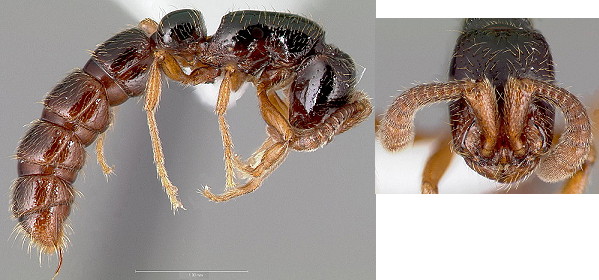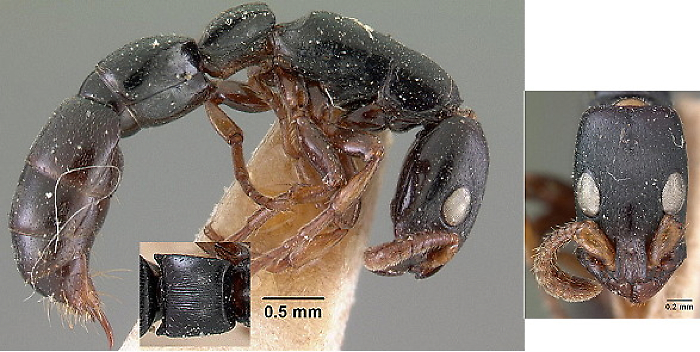SUBFAMILY CERAPACHYINAE Wheeler, 1902d: 185
| The Ants of Africa SUBFAMILY CERAPACHYINAE Wheeler, 1902d: 185 |
Diagnostic Features - Head with clypeus narrow so that antennal insertions are quite close to the anterior margin of the head, frontal carinae raised exposing the condylar bulbs of the antennae. Antenna thick with short clavate scapes and funiculi. Eyes usually present, may be minute or absent. Alitrunk box-like and rigid, with dorsum devoid of sutures. Petiole of a single segment, although the constriction between the first and second gastral segments may be very deep, such that petiole is effectively two-segmented. Pygidium impressed, armed laterally or posteriorly with spines or denticulae. Sting well developed and functional. Essentially monomorphic, though often with a considerable range of sizes in a single species and even in a single nest series (Brown, 1975).
Revisions by Brown (1975: 18), who synonymized Phyracaces with Cerapachys F. Smith (1857a: 75) and had Cerapachyini, as a ponerine tribe, and by Bolton (1990a, 1990b) who considered it as a member of the doryline section. This is where Hölldobler & Wilson (1990) have them but the subfamily was resurrected by Bolton (1994), was used by Belshaw & Bolton (1994b), and remains in Bolton (1995). It seems sensible, therefore, to retain the subfamily.
If I understand them correctly, Brady et al. (2014) provide evidence from DNA studies that the genera listed in the key (below), together with the Madagascar genus Tanipone (see Antweb) fall within Dorylinae but are separable from true "army ants". Within Cerapachys
they found a group with marked lateral margination on the petiole was
distinct enough to perhaps warrant elevation to genus status under the
name Lioponera. As yet, however, that seems to remain invalid as a formal published genus. For the Old World Sphinctomyrmex which were separable from the New World forms, including the genus type species S. stali, they "informally" used the next oldest available name Eusphinctus (type species furcatus an Asian species). Similarly, that remains informal (as at November 2015).
Reference:
Brady, S. G., Fisher, B. L., Schultz, T. R. & Ward, P. S. 2014. The
rise of army ants and their relatives: diversification of specialized
predatory doryline ants. BMC Evolutionary Biology 2014 14:93, 14 pp. (doi:10.1186/1471-2148-14-93). PDF 142599
Separation of genera
| 1 | Middle legs with tibial spurs; pretarsal claws always simple | 2 |
| -- | Middle legs without tibial
spurs; pretarsal and metatarsal claws with a preapical tooth |
3 |
| 2 |  Gaster with marked
constrictions between segments 1 & 2, 2 & 3 and 3 & 4;
pygidium exposed dorsally, pointed, rounded or excavated, and armed
with numerous minute spinules; African workers have not formally been
described but appear to be eyeless Gaster with marked
constrictions between segments 1 & 2, 2 & 3 and 3 & 4;
pygidium exposed dorsally, pointed, rounded or excavated, and armed
with numerous minute spinules; African workers have not formally been
described but appear to be eyeless |
Sphinctomyrmex |
| -- |  Gaster with constriction
only between segments 1 & 2 Gaster with constriction
only between segments 1 & 2 |
Cerapachys |
| 3 |  Antennae with 11 segments Antennae with 11 segments |
Simopone |
| -- |  Antennae with
12 segments; TL 2.4-3.4 mm; shining
yellow species, with an elongate petiole Antennae with
12 segments; TL 2.4-3.4 mm; shining
yellow species, with an elongate petiole |
West Africa & Congo Basin - Vicinopone conciliatrix |
|
© 2007, 2008, 2009, 2010, 2013 - Brian Taylor CBiol
FSB FRES 11, Grazingfield, Wilford, Nottingham, NG11 7FN, U.K. |
href="clog5.htm"